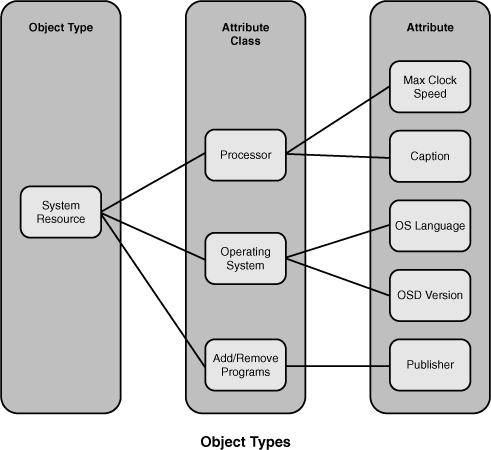The built-in queries are just a sample of the data
available in ConfigMgr. You will want to review the properties of the
built-in queries to get a better idea of how they are created, and then
begin building your own queries!
Creating queries is a safe
way to obtain data from ConfigMgr. When you use the Query Builder, the
class joins are automatically created, thus reducing the risk of an
improper join that could be resource intensive. The following sections
provide additional insight into the query language, as well as the types
of objects you can query.
The Query Language
ConfigMgr queries use the
WMI Query Language (WQL) to gather information from the site database.
In this way, queries differ from Configuration Manager reports , which use standard SQL syntax to access database
information. ConfigMgr uses WMI for much more than just ConfigMgr
queries. The ConfigMgr Software Development Kit (SDK) is a great place
to learn more about WMI and WQL as well as Configuration Manager’s use
of these technologies.
|
As Microsoft states at http://msdn.microsoft.com/en-us/library/aa394606(VS.85).aspx,
WQL is a subset of the American National Standards Institute Structured
Query Language (ANSI SQL) with minor semantic changes. This MSDN site
lists WQL keywords. The keywords built with WQL are used to control the
WMI service. Think of it as a repository of properties and methods
related to the system environment that you would access similar to
accessing a database. |
Objects, Classes, and Attributes
Prior
to building queries, let’s discuss the terminology and the objects you
will use. When selecting data in a query, you select an object type, one or more attribute classes, and one or more attributes. These terms are defined in the following list:
Object type— A set of attributes that represents a ConfigMgr database object, such as a client, package, or advertisement. Table 1 shows the object types available for queries.
Table 1. Object Types Available for ConfigMgr Queries
| Object Type | Description |
|---|
| Advertisement | A
single attribute class that contains the data in a ConfigMgr
advertisement, such as advertisement name, advertisement ID, package ID,
package name, and more. This class will not tell you the advertisement
status, but describes the properties of an advertisement. |
| Software Metering Rules | A
single attribute class containing the data in a ConfigMgr software
metering rule, such as rule name, filename to meter, and whether the
rule is enabled. This class will not tell you metering rule summary
information, but will tell you the properties of the rule. |
| Package | A single attribute class that contains the data in a ConfigMgr package, such as package name, package ID, source path, and more. |
| Program | A
single attribute class containing the data in a ConfigMgr program, such
as program name, package ID (to associate the program with a package),
dependent program package information, and more. |
| Site | A single attribute class that contains the data in a ConfigMgr site, such as server name, build number, and site version. |
| System Resource | Many
attribute classes containing the data for a computer system, such as
discovery information, hardware and software information, and so on, are
System Resource objects.
|
| User Resource | A
single attribute class that contains the discovery data for user
objects, such as user name, full user name, and user Organizational Unit
(OU). Use this class when building queries that can be imported into
collections for user-targeted advertisements. |
| User Group Resource | A
single attribute class containing the discovery data for user group
objects, such as user group name and domain. Use this class when
building queries that can be imported into collections for user
group–targeted advertisements. |
Attribute class— A
container object that groups related attributes. For example, the
Processor attribute class contains attributes such as Device ID,
Manufacturer, Resource ID, and more. You can control many of the
attributes in the attribute class by modifying the attributes collected
in inventory by modifying the SMS_Def.mof file. Most attributes you will
use in ConfigMgr queries are members of the System Resource Object
type, because all hardware and software inventory information is a
member of this object type. If later you decide to build
a web report (which uses SQL instead of WQL), you will find a SQL view
with a similar name. As an example, the Computer System attribute class
in WQL has a corresponding SQL view named v_GS_COMPUTER_SYSTEM.
Attribute— The specific property that the query searches in criteria and/or displays for query results.
Figure 1
provides an example of object types and their relationships discussed
in this section. It shows the selected object type System Resource.
Within the System Resource object type, three attribute classes
(Processor, Operating System, and Add/Remove Programs) are selected. The
lines between each object type represent the joins that are required
between classes. Here is the WQL equivalent of Figure 1:
select SMS_G_System_PROCESSOR.MaxClockSpeed, SMS_G_System_PROCESSOR.Name,
SMS_G_System_OPERATING_SYSTEM.OSLanguage,
SMS_G_System_OPERATING_SYSTEM.Version,
SMS_G_System_ADD_REMOVE_PROGRAMS.Publisher from SMS_R_System inner join
SMS_G_System_PROCESSOR on SMS_G_System_PROCESSOR.ResourceId =
SMS_R_System.ResourceId inner join SMS_G_System_OPERATING_SYSTEM on
SMS_G_System_OPERATING_SYSTEM.ResourceId = SMS_R_System.ResourceId inner join
SMS_G_System_ADD_REMOVE_PROGRAMS on
SMS_G_System_ADD_REMOVE_PROGRAMS.ResourceId = SMS_R_System.ResourceId

As you can see from this
code, WQL looks very similar to SQL. You will also notice that no
criterion is specified (the query does not contain a WHERE clause). This particular example did not specify criteria, which is another feature of ConfigMgr queries—you may want to see all the data on occasion. You will learn in the next section how you can easily create a WQL query with criterion.